Anatomy of a Recount
Early Tuesday, the lower-level conference room of the County Building at 200 N. Main was filled with the scent of freshly-groomed election inspectors, board of canvassers members, candidates and their volunteer observers, county workers, plus the odor of institutional coffee wafting from a big silver urn. The combination amounted to a distinctive smell, which The Chronicle loves … the smell of democracy in the morning.
We were there to recount the votes from the Ward 5 Democratic primary election for city council held in August, at the request of Vivienne Armentrout, who had been outpolled by Carsten Hohnke by 58 votes in an election that saw over 3,000 votes cast. “Campaigning for council,” Armentrout said that morning, “is a long hard slog.” She said that various reports of election-day problems that had been relayed to her prompted her to seek the recount. Those problems included an optical scanning machine that broke down and had to be replaced with a different machine, and ballots jamming in the machine.
Washtenaw County uses paper ballots, which are fed into an optical scanner that reads the darkened ovals next to a candidate’s name as a vote cast for that candidate. City clerk Jacqueline Beaudry explained for The Chronicle that the scanning machines themselves – i.e., the hardware – are the responsibility of the city, whereas the programming is done by the county.
Before the election, the city receives a programmed chip from the county, together with a set of sample ballots representing every possible combination of votes, which are used to test each machine before the election. Once the machine is tested, the programmed chip is sealed inside.
For Chronicle readers who would like to compute how many sample ballots will have been provided to the city by the county for the election we were there to recount, we provide a copy of the ballot: [.pdf from publius.org]
Before the business of counting began, chair of the board of canvassers, Melodie Gable, got things started by asking folks to introduce themselves – in particular the candidates and the volunteer observers they’d brought along. Helping Vivienne Armentrout observe were Rita Mitchell, Susan Greenberg, Pat Ryan, Lou Glorie, and Barbara Kritt.
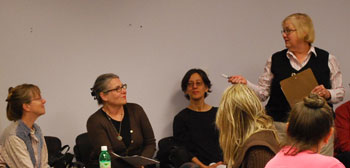
Vivienne Armentrout (standing) introduces those helping her observe. Left to right: Rita Mitchell, Lou Glorie, Barbara Kritt. Not in this frame were also Susan Greenberg and Pat Ryan.
Carsten Hohnke introduced Tony Derezinski, Anja Lehmann, Joan Lowenstein, Leigh Greden, Christopher Taylor, and Dieter Hohnke. Names like Derezinski, Lowenstein, and Greden will likely be recognized by Chronicle readers even out of the context of an election recount. Less so, a name like Kritt.
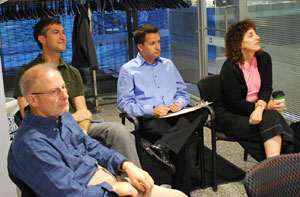
Helping Hohnke observe were, left to right: Dieter Hohnke, Christopher Taylor, Leigh Greden, Joan Lowenstein. Not in this frame, Tony Derezinski, Anja Lehmann.
Chatting with Kritt, she revealing that back in the early 1990s, she was living in Nicaragua and had participated in the observation of elections held in Nicaragua, working in the capitol, Managua, receiving field reports from polling sites throughout the country. At that time she worked as a sociologist, as she does now in Ann Arbor, where she’s lived for more than a decade. Kritt didn’t know Armentrout before she launched her campaign for council.
Gable handed things off to Chief Deputy Clerk Derrick Jackson, who walked election inspectors through the precinct-by-precinct recount process, emphasizing that if the first two steps cannot be successfully completed for a given precinct, there can be no actual counting of votes for candidates, and that the vote totals already recorded would be accepted:
- The seal on the blue canvas duffel must match the number recorded on the poll book.
- The number of ballots (i.e., pieces of paper) must match the number recorded in the poll book.
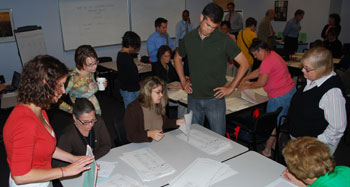
Left to right: unidentified, Lou Glorie (observing for Armentrout), Jacqueline Beaudry (city clerk), unidentified, Christopher Taylor (observing for Hohnke), Vivienne Armentrout.
If the paper count is off, election inspectors are required to count exactly once more. The paper count in precinct 5-11 was initially short by seven ballots, but election inspectors working that table quickly found six ballots that had been folded, hence missed in the count.
Chief Deputy Clerk Jackson explained that the finding of the six additional ballots did not constitute a second count and that the count should be repeated. The second count confirmed that the bag was short by one ballot. So for precinct 5-11, there would be no tallying of votes for either candidate.
The tallying process itself has multiple checks for accuracy baked right in:
- at least three people are required – a reader plus two tally members
- the reader looks at each ballot in turn, and says aloud who the ballot is for
- tally members record hash marks on tally forms, up to five hash marks per cell
- every fifth vote for either candidate, tally members say “check”
- every tenth ballot – counted by the reader or some other non-tally member – tally members circle the last vote counted for each candidate.
As the tallying commenced, a predictable range of pronunciations for “Hohnke” could be heard. Perhaps it was uncertainly about “-kee” versus “-kuh” plus the tri-syllabic lengthiness of “Arm-en-trout” that led one reader to abbreviate the candidates’ names as she called out the votes for the tally members: “hahn, arm, arm, hahn, hahn, arm …”
Observers can raise questions for clarification with board of canvassers members, who circulate around the room. What kinds of questions arise? That morning, one involved a mark in the margin of the ballot that could have represented any number of things, depending on your vantage point. From The Chronicle’s vantage point, it looked like a heart, but oriented as the voter would have written on the ballot, the mark more closely reassembled a letter B. Board of canvassers member Kim Porter-Hoppe suggested it could be the numeral 13.

Rita Mitchell (standing, observing for Armentrout), Albert Pfeiffer, Janis Miller (election inspectors).
Whatever it was, Hohnke insisted that this was an “identifying mark” under Michigan state election law and that the ballot should be voided. That protest was not honored, however, with the explanation that a voter can pretty much write whatever they like on their ballot, including their name. The Chronicle suspects that even if the analysis of this particular mark was accurate, the explanation is inaccurate.
A question on a different ballot arose first when an election inspector, Janis Miller, sought advice from the board of canvassers about whether the marking of the oval next to “Carsten Hohnke” should be counted. The initial answer was no, but when Hohnke objected, Derrick Jackson interceded and explained that the X recorded on the ballot need not be perfectly centered inside the oval. So Hohnke kept his vote on that ballot.
In that case of the off-kilter X, it was the election inspector who first raised the question – and in general the inspectors are the people who wield the real power in the room. “Derrick, it’s getting loud in here!” was all it took for one election inspector to bring the noise level down. The noise stemmed from simultaneous counting taking place at four different tables, plus idle chit-chat between observers.
Pre-tallying conversations with Hohnke and Armentrout conveyed that The Chronicle’s real mission that day was to determine what names, if any, had been written in for the six ballots recorded as write-ins. Armentrout and Hohnke themselves, as well as their observers, helped feed The Chronicle what they saw: “Abstain,” “Jackie Chan,” “Sandi Smith,” “Dan Schaefer.”
The vote for Sandi Smith, who was a candidate for council in Ward 1, probably stemmed from the several signs for her that were posted in Ward 5. The significance of the other votes is hard to assess. Even harder to fathom is why someone would write in “Hillary Clinton” for drain commissioner.
As the results of the precincts began to be recorded on the big white-board, most of which matched the prior totals, it became increasingly unlikely that there would be the kind of vote differences that would change the outcome of the election. As The Chronicle previously reported, the outcome was not changed. By the time the final precinct was re-counted, the smell of democracy had given way to the smell of pizza, which arrived from Papa John’s towards 1 p.m.
The election inspectors would need the fuel from the pizzas to get them through the second recount of the day, which the same inspectors carried out despite the initial decision by the board of canvassers to deny Jan BenDor’s request (candidate for clerk in the Democratic primary in Superior Township) for a recount. That initial decision was based on the fact that BenDor’s request alleged fraud of a kind that a recount could not address. However, BenDor and her supporters were able to convince the board of canvassers to perform the recount.




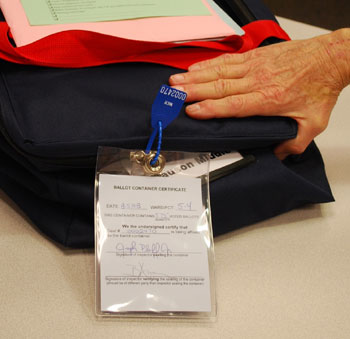
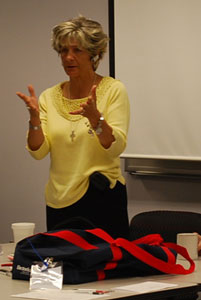
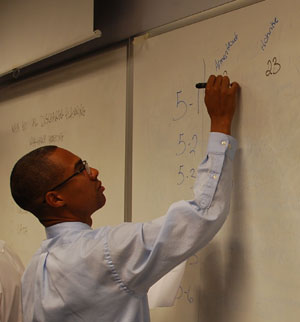
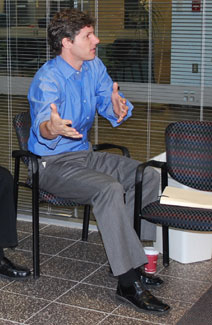
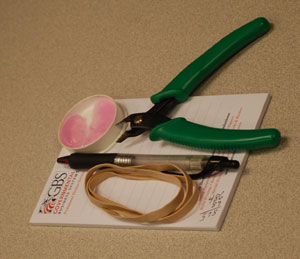
Fascinating. Bonus points for “…a predictable range of pronunciations…” Thanks.
A well-done and important article!
Excellent article. Very info-intensive. The 2000 Florida and 2004 Ohio presedential elections could have used some media scrutiny like this.